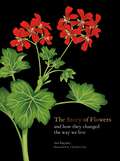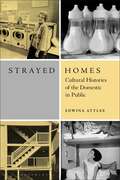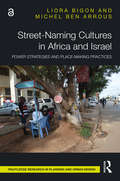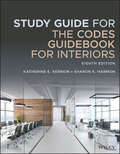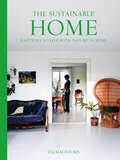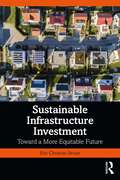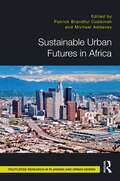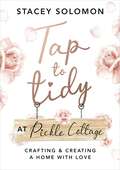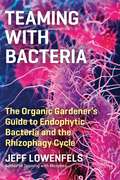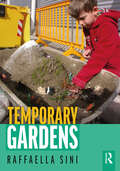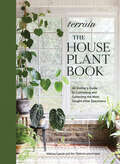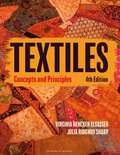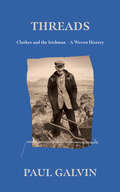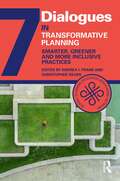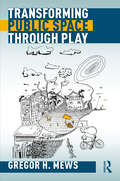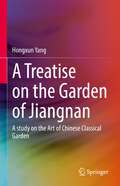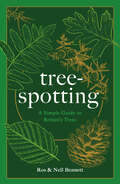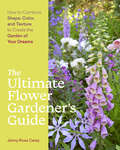- Table View
- List View
The Story of Flowers: And How They Changed the Way We Live
by Noel KingsburyThroughout history flowers have been an integral part of human survival and culture – as food, for medicine, to express feelings, as symbols, to commemorate and celebrate, and to decorate. Their shapes, colours, scents and textures have always attracted us, as they do animals and insects. Flowers are used as luxury spices (saffron), and as colouring and flavouring agents – marigolds fed to chickens make eggs more yellow and lavender was Elizabeth I’s favourite flavour of jam. Flowers are full of symbolic meaning: violets represent modesty, daises purity and daffodils unrequited love. And they have always played an important role in culture through myths and legends, literature and the decorative arts. This delightful new book brings together 100 of the world’s flowers to tell their remarkable stories. Each flower is richly illustrated in colour and accompanied by facts about each species and what role it has played in our culture and history.
Strayed Homes: Cultural Histories of the Domestic in Public
by Edwina AttleeStrayed Homes explores the blurring of public and private space. But whereas most writing about the public/private focusses on urban space, Strayed Homes focusses on the domestic – exploring those overlooked, everyday places where private and intimate activities take place in public.With four chapters set in four small, liminal spaces: the launderette, the greasy spoon, the fire escape, and the sleeper train - the book is part architectural history, part cultural history. It follows a series of allusions and impressions, to explore how films, adverts, books and anecdotes shape experiences of everyday architecture. Making a case for the poetic interpretation of space, the book can be used as a sourcebook for architects and designers as well as for theorists. It invites the reader – by embracing the notion of the 'strayed home' – to think again about concepts that are commonly invoked in the fields of architecture and urbanism, such as 'private', 'public' and 'home', and to rethink the emotional state of leaving home, intimacy in public, and lonely dreaming.
Street-Naming Cultures in Africa and Israel: Power Strategies and Place-Making Practices
by Liora Bigon Michel Ben ArrousThis book is focused on the street-naming politics, policies and practices that have been shaping and reshaping the semantic, textual and visual environments of urban Africa and Israel. Its chapters expand on prominent issues, such as the importance of extra-formal processes, naming reception and unofficial toponymies, naming decolonisation, place attachment, place- making and the materiality of street signage. By this, the book directly contributes to the mainstreaming of Africa’s toponymic cultures in recent critical place-names studies. Unconventionally and experimentally, comparative glimpses are made throughout between toponymic experiences of African and Israeli cities, exploring pioneering issues in the overwhelmingly Eurocentric research tradition. The latter tends to be concentrated on Europe and North America, to focus on nationalistic ideologies and regime change and to over-rely on top-down ‘mere’ mapping and street indexing. This volume is also unique in incorporating a rich and stimulating variety of visual evidence from a wide range of African and Israeli cities. The materiality of street signage signifies the profound and powerful connections between structured politics, current mundane practices, historical traditions and subaltern cultures. Street-Naming Cultures in Africa and Israel is an important contribution to urban studies, toponymic research and African studies for scholars and students.
Street-Naming Cultures in Africa and Israel: Power Strategies and Place-Making Practices
by Liora Bigon Michel Ben ArrousThis book is focused on the street-naming politics, policies and practices that have been shaping and reshaping the semantic, textual and visual environments of urban Africa and Israel. Its chapters expand on prominent issues, such as the importance of extra-formal processes, naming reception and unofficial toponymies, naming decolonisation, place attachment, place- making and the materiality of street signage. By this, the book directly contributes to the mainstreaming of Africa’s toponymic cultures in recent critical place-names studies. Unconventionally and experimentally, comparative glimpses are made throughout between toponymic experiences of African and Israeli cities, exploring pioneering issues in the overwhelmingly Eurocentric research tradition. The latter tends to be concentrated on Europe and North America, to focus on nationalistic ideologies and regime change and to over-rely on top-down ‘mere’ mapping and street indexing. This volume is also unique in incorporating a rich and stimulating variety of visual evidence from a wide range of African and Israeli cities. The materiality of street signage signifies the profound and powerful connections between structured politics, current mundane practices, historical traditions and subaltern cultures. Street-Naming Cultures in Africa and Israel is an important contribution to urban studies, toponymic research and African studies for scholars and students.
Study Guide for The Codes Guidebook for Interiors
by Katherine E. Kennon Sharon K. HarmonSTUDY GUIDE FOR THE CODES GUIDEBOOK FOR INTERIORS The comprehensive study guide for understanding interior codes This revised and updated eighth edition of the Study Guide for the Codes Guidebook for Interiors is an essential companion to The Codes Guidebook for Interiors, the industry’s reference of choice. It offers complete coverage of the major codes and standards that apply to interior projects. This Study Guide includes lists of terms, practice questions, practical application exercises, code tables, and checklists. This companion study guide is a comprehensive measure of a designer’s understanding and application of codes for interior projects. It can help design students learn and practitioners keep their skills up to date and prepare for the NCIDQ and ARE exams. It is vital that designers and architects have an up-to-date working knowledge of the various codes involved with building interiors, whether during renovation or new construction, and this study guide offers the opportunity to: Study with many new questions, in both the short answer and application sections Review the key terms of the industry Use the practice questions and exercises to test working knowledge of codes Utilize the code tables during the design process Employ the numerous checklists on proposed and real life projects to ensure complete compliance The revised Study Guide is a useful companion to The Codes Guidebook for Interiors, the essential reference for all interior professionals. For the designer, architect, or student, the Study Guide for The Codes Guidebook for Interiors is a must-have resource.
Study Guide for The Codes Guidebook for Interiors
by Katherine E. Kennon Sharon K. HarmonSTUDY GUIDE FOR THE CODES GUIDEBOOK FOR INTERIORS The comprehensive study guide for understanding interior codes This revised and updated eighth edition of the Study Guide for the Codes Guidebook for Interiors is an essential companion to The Codes Guidebook for Interiors, the industry’s reference of choice. It offers complete coverage of the major codes and standards that apply to interior projects. This Study Guide includes lists of terms, practice questions, practical application exercises, code tables, and checklists. This companion study guide is a comprehensive measure of a designer’s understanding and application of codes for interior projects. It can help design students learn and practitioners keep their skills up to date and prepare for the NCIDQ and ARE exams. It is vital that designers and architects have an up-to-date working knowledge of the various codes involved with building interiors, whether during renovation or new construction, and this study guide offers the opportunity to: Study with many new questions, in both the short answer and application sections Review the key terms of the industry Use the practice questions and exercises to test working knowledge of codes Utilize the code tables during the design process Employ the numerous checklists on proposed and real life projects to ensure complete compliance The revised Study Guide is a useful companion to The Codes Guidebook for Interiors, the essential reference for all interior professionals. For the designer, architect, or student, the Study Guide for The Codes Guidebook for Interiors is a must-have resource.
The Sustainable Home: Easy Ways To Live With Nature In Mind
by Ida MagntornHandy and inspirational tips and lists – how to reduce plastic consumption, clean with eco-friendly products and working with the seasons to bring the outdoors inside. A beautifully produced book on interiors with a focus on sustainability and wellbeing and creating a home with the environment in mind.
Sustainable Infrastructure Investment: Toward a More Equitable Future
by Eric Christian BruunThis book provides examples and suggestions for readers to understand how public investment decisions for sustainable infrastructure are made. Through detailed analysis of public investment in infrastructure over the last few decades in the United States, the United Kingdom, and Finland, the author explores how the decision-making processes for major public works spending, many of them requiring quite rigorous and detailed computational methodologies, can result in plans that underserve large portions of the population, are inequitable, and fail to efficiently preserve public property. Beginning with some of the commonly offered explanations for the slow pace of investment and repair in a supposedly prosperous society facing serious environmental challenges, the book then explores media’s role in shaping the public-at-large’s understanding of the situation and the unimaginative solutions put forward by politicians. It continues with some case studies of infrastructure investment, or lack thereof, including an exploration of competing uses for government funds. It concludes with some suggestions. It is aimed at a large readership of professionals, students, and policy makers in political science, urban planning, and civil engineering.
Sustainable Infrastructure Investment: Toward a More Equitable Future
by Eric Christian BruunThis book provides examples and suggestions for readers to understand how public investment decisions for sustainable infrastructure are made. Through detailed analysis of public investment in infrastructure over the last few decades in the United States, the United Kingdom, and Finland, the author explores how the decision-making processes for major public works spending, many of them requiring quite rigorous and detailed computational methodologies, can result in plans that underserve large portions of the population, are inequitable, and fail to efficiently preserve public property. Beginning with some of the commonly offered explanations for the slow pace of investment and repair in a supposedly prosperous society facing serious environmental challenges, the book then explores media’s role in shaping the public-at-large’s understanding of the situation and the unimaginative solutions put forward by politicians. It continues with some case studies of infrastructure investment, or lack thereof, including an exploration of competing uses for government funds. It concludes with some suggestions. It is aimed at a large readership of professionals, students, and policy makers in political science, urban planning, and civil engineering.
Sustainable Urban Futures in Africa
by Michael Addaney Patrick CobbinahSustainable Urban Futures in Africa provides a variety of conventional and emerging theoretical frameworks to inform understandings and responses to critical urban development issues such as urbanisation, climate change, housing/slum, informality, urban sprawl, urban ecosystem services and urban poverty, among others, within the context of the sustainable development goals (SDGs) in Africa. This book addresses topics including challenges to spatial urban development, how spatial planning is delivered, how different urbanisation variables influence the development of different forms of urban systems and settlements in Africa, how city authorities could use old and new methods of land administration to produce sustainable urban spaces in Africa, and the role of local activism is causing important changes in the built environment. Chapters are written by a diverse range of African scholars and practitioners in urban planning and policy design, environmental science and policy, sociology, agriculture, natural resources management, environmental law, and politics. Urban Africa has huge resource potential – both human and natural resources – that can stimulate sustainable development when effectively harnessed. Sustainable Urban Futures in Africa provides support for the SDGs in urban Africa and will be of interest to students and researchers, professionals and policymakers, and readers of urban studies, spatial planning, geography, governance, and other social sciences.
Sustainable Urban Futures in Africa
by Patrick Brandful CobbinahSustainable Urban Futures in Africa provides a variety of conventional and emerging theoretical frameworks to inform understandings and responses to critical urban development issues such as urbanisation, climate change, housing/slum, informality, urban sprawl, urban ecosystem services and urban poverty, among others, within the context of the sustainable development goals (SDGs) in Africa. This book addresses topics including challenges to spatial urban development, how spatial planning is delivered, how different urbanisation variables influence the development of different forms of urban systems and settlements in Africa, how city authorities could use old and new methods of land administration to produce sustainable urban spaces in Africa, and the role of local activism is causing important changes in the built environment. Chapters are written by a diverse range of African scholars and practitioners in urban planning and policy design, environmental science and policy, sociology, agriculture, natural resources management, environmental law, and politics. Urban Africa has huge resource potential – both human and natural resources – that can stimulate sustainable development when effectively harnessed. Sustainable Urban Futures in Africa provides support for the SDGs in urban Africa and will be of interest to students and researchers, professionals and policymakers, and readers of urban studies, spatial planning, geography, governance, and other social sciences.
Tap to Tidy at Pickle Cottage: Crafting & Creating a Home with Love
by Stacey Solomon'To say we are excited for the release of this book is a massive understatement' Closer'Fun, practical and friendly - like Solomon herself' Guardian'This book is for you to use as a guide, as inspiration, or even just to read without any pressure to do anything at all! Grab a cuppa and dip in and out of it at leisure. I want you to know that you really do have the skill to do anything you want - don't let anyone tell you otherwise. Having your own home is something we all dream about. I hope this book will give you the confidence to pick up a drill, paint brush, hammer or a hack saw and make your space the home of your dreams.' Stace xxDiscover Stacey's Tap to Tidy DIY Method - with steps on how to get started. Each chapter takes readers round a room in Stacey's dream home, and how she transformed each room herself.Each chapter includes:· Hero projects: Big renovation or organisational projects· Quick fixes: Small jobs to spruce up a room· Make-ups: My transformative craft projects and accessories· Little things I love: Power tools, amazing DIY products, my favourite accessories...· Tips: Stacey's tips to make your projects run smoothly· Expert help: tips on when you need to call in the experts
Teaming with Bacteria: The Organic Gardener's Guide to Endophytic Bacteria and the Rhizophagy Cycle
by Jeff LowenfelsJust as Teaming with Microbes introduced readers to the soil food web, Teaming with Bacteria will introduce the latest research on endophytic bacteria and rhizophagy—discoveries that have profound implications for the practices of home gardeners and small-scale growers.
Temporary Gardens
by Raffaella SiniThe last 30 years have seen a surge in temporary gardens. The flexibility and new challenges invested in non-permanent landscapes has made them a creative and stimulating testing ground for professionals and impromptu designers. Raffaella Sini examines the historical evolution of the genre, exploring theory, narratives, and strategies informing 80 temporary gardens built in France, Germany, Spain, Portugal, Italy, the United Kingdom, Belgium, Switzerland, Sweden, New Zealand, Canada, Singapore, and the United States. Key topics include: • temporary gardens in 1970s avant-garde art and 1980s public art; • temporary gardens as opportunities to work with live processes, practice inclusion, and explore concepts of social justice and ecology; • temporary gardens to redefine the vocabulary of garden design; and • temporary gardens in tactical urbanism. The book comprehensively decodifies the full range of ephemeral gardens: uprooted, mobile, itinerant, movable, postmodern, installation, exhibited, conceptual, theme, pop-up, guerrilla, grassroots, meanwhile, interim, provisional, activist, community, and parklet. Beyond physical duration, time-focused design in gardens affects the entire process of conceiving, building, experiencing, and managing green spaces; using short-term formats, anyone can invent, trial, and experiment in a condensed experience of landscape. The temporary garden emerges as critical cultural ground for the discourse in landscape architecture, art, ephemeral urbanism, and in urban, landscape, and garden design. It is inspirational reading for designers and students alike.
Temporary Gardens
by Raffaella SiniThe last 30 years have seen a surge in temporary gardens. The flexibility and new challenges invested in non-permanent landscapes has made them a creative and stimulating testing ground for professionals and impromptu designers. Raffaella Sini examines the historical evolution of the genre, exploring theory, narratives, and strategies informing 80 temporary gardens built in France, Germany, Spain, Portugal, Italy, the United Kingdom, Belgium, Switzerland, Sweden, New Zealand, Canada, Singapore, and the United States. Key topics include: • temporary gardens in 1970s avant-garde art and 1980s public art; • temporary gardens as opportunities to work with live processes, practice inclusion, and explore concepts of social justice and ecology; • temporary gardens to redefine the vocabulary of garden design; and • temporary gardens in tactical urbanism. The book comprehensively decodifies the full range of ephemeral gardens: uprooted, mobile, itinerant, movable, postmodern, installation, exhibited, conceptual, theme, pop-up, guerrilla, grassroots, meanwhile, interim, provisional, activist, community, and parklet. Beyond physical duration, time-focused design in gardens affects the entire process of conceiving, building, experiencing, and managing green spaces; using short-term formats, anyone can invent, trial, and experiment in a condensed experience of landscape. The temporary garden emerges as critical cultural ground for the discourse in landscape architecture, art, ephemeral urbanism, and in urban, landscape, and garden design. It is inspirational reading for designers and students alike.
Terrain: An Insider's Guide to Cultivating and Collecting the Most Sought-After Specimens
by Melissa Lowrie&“An informative and inspiring guide to collecting and growing plants at home.&”—Gardenista &“This book is a must-have!&”—Hilton Carter, author of Wild at Home, Wild Interiors, and Wild CreationsSecrets of the Houseplant Hunters Terrain&’s plant experts travel the world in search of the most unusual and interesting houseplants. In this inspiring and practical guide, they share their favorite specimens: exotic and eclectic ferns, like the skeleton fork, a primitive (and unfussy) predecessor to the family; new aroids to feed that monstera obsession; and adventurous trailing plants like dischidia, which is found cascading from tree branches in its native Thailand; plus succulents and cacti, indoor trees, the best low-care plants, and &“rule breakers&” like bamboo muhly grass that can make an unexpected move indoors. Along the way, Terrain introduces their favorite independent growers—passionate plant lovers who are creating new hybrids and bringing back old-school specimens to the market. And readers learn Terrain&’s way of styling and overarching philosophy on care: the most important thing we can give our plants is our presence.
Textiles: Concepts and Principles - with STUDIO
by Virginia Hencken Elsasser Julia Ridgway Ridgway SharpTextiles: Concepts and Principles, Fourth Edition provides a thorough approach to the fundamentals of textiles in a readable, nontechnical style, focusing on the interrelationship of textile components to help students understand and predict textile properties and performance to ultimately choose the best textile for their final product. With new co-author Julia Ridgway Sharp, Virginia Hencken Elsasser covers the global textile industry and components of textile products, summarizes laws and regulations affecting the textile industry, and looks into career possibilities, properties, care instructions, end uses of natural and manufactured fibers, yarns, fabrics, coloration and finishes, and the overall impact of textiles on the environment.New to this Edition-Updated information on sustainability, laws and regulations, and technological advancements- New Did you know? feature in each chapter provides thoughtful insights into new developments in the textile industry-Inclusion of imperial and metric measurements for a more global scopeSTUDIO Features Include-Study smarter with self-quizzes featuring scored results and personalized study tips -Review concepts with flashcards of essential vocabulary -Download additional exercises to practice your skills Instructor Resources-Instructor's Guide with Test Bank provides suggestions for planning the course and using the text in the classroom, supplemental assignments, and lecture notes-Test Bank includes sample test questions for each chapter-PowerPoint® presentations include images from the book and provide a framework for lecture and discussion
Threads: Clothes and the Irishman - A Woven History
by Paul GalvinTaking the clothes they wore as a starting point, Paul Galvin skilfully weaves together a collection of stories of Irishmen who defined the culture and mood of their time.In Push, he tells the story of the legendary Walker Brothers – cyclists and soldiers who pedalled through a storm for Ireland at the 1912 Stockholm Games and subsequently served as rebel bike couriers during the 1916 Rising. In Born Mad, discover another side to Samuel Beckett – sartor and prolific sportsman who had knockout power as a champion school’s boxer. In Boland, we learn about Harry Boland’s background as a trained tailor, and in Jack, we encounter Jack B. Yeats at the 1924 Olympic Games in Paris.These are just some of men who have inspired Paul’s own fashion collections and whom he writes about here in a fascinating collection that shines a light on how history is woven into the clothes Irishmen wear.
Transformative Planning: Smarter, Greener and More Inclusive Practices
by Andrea I. Frank Christopher SilverThe Dialogues in Urban and Regional Planning series offers a selection of some of the best scholarship in urban and regional planning from around the world with internationally recognized authors taking up urgent and salient issues from theory, to education for and practice of planning. This 7th volume features contributions on the theme of Transformative Planning: Smarter, Greener and More Inclusive Practices. It includes chapters from leading planning scholars and practitioners who critically examine how transformative planning practices seek to reduce inequalities, promote sustained, inclusive and sustainable economic growth, achieve gender equality, improve human health and well-being, foster resilience of urban communities and protect the environment and thereby change urban planning paradigms. Several case studies of emerging transformative planning interventions illustrate practical ways forward. Transformative Planning offers provocative insights into the global planning community’s struggle and contribution to tackle the major challenges to society in the 21st century. It will be of use for advanced undergraduate and graduate courses in the wide-ranging fields encompassed by urban studies, sustainability studies, and urban and regional planning. The Dialogues in Urban and Regional Planning (DURP) series is published in association with the Global Planning Education Association Network (GPEAN) and its member national and transnational planning schools associations.
Transformative Planning: Smarter, Greener and More Inclusive Practices
by Andrea I. FrankThe Dialogues in Urban and Regional Planning series offers a selection of some of the best scholarship in urban and regional planning from around the world with internationally recognized authors taking up urgent and salient issues from theory, to education for and practice of planning. This 7th volume features contributions on the theme of Transformative Planning: Smarter, Greener and More Inclusive Practices. It includes chapters from leading planning scholars and practitioners who critically examine how transformative planning practices seek to reduce inequalities, promote sustained, inclusive and sustainable economic growth, achieve gender equality, improve human health and well-being, foster resilience of urban communities and protect the environment and thereby change urban planning paradigms. Several case studies of emerging transformative planning interventions illustrate practical ways forward. Transformative Planning offers provocative insights into the global planning community’s struggle and contribution to tackle the major challenges to society in the 21st century. It will be of use for advanced undergraduate and graduate courses in the wide-ranging fields encompassed by urban studies, sustainability studies, and urban and regional planning. The Dialogues in Urban and Regional Planning (DURP) series is published in association with the Global Planning Education Association Network (GPEAN) and its member national and transnational planning schools associations.
Transforming Public Space through Play
by Gregor H. MewsThis book provides an empirical analysis of the concept of play as a form of spatial practice in urban public spaces. The introduced City–Play–Framework (CPF) is a practical urban analysis tool that allows urban designers, landscape architects and researchers to develop a shared awareness when opening up this window of possibility for adventure. Two case studies substantiate and illustrate the development process and testing of the framework in Canberra, Australia, and Potsdam, Germany. The appropriation of public spaces that transcend boundaries can facilitate an intrinsic connection between people and their immediate environment, towards a more joyful ontological state of human existence in which imagination, co-creation and a sense of agency are key elements of the design approach. The framework presents an alternative understanding of public spaces and public life, reflecting on theory and its implications for practice in a post-pandemic world in dense urban centres. A bridge between theory and practice, this book explores possibilities on what future design ought to be when openness and ambiguity are consciously integrated parts of practice and process. The book presents a valuable discussion on public space and play for academic audiences across a wide range of disciplines such as landscape architecture, urban design, planning, architecture and urban sociology, which is informative for future practice.
Transforming Public Space through Play
by Gregor H. MewsThis book provides an empirical analysis of the concept of play as a form of spatial practice in urban public spaces. The introduced City–Play–Framework (CPF) is a practical urban analysis tool that allows urban designers, landscape architects and researchers to develop a shared awareness when opening up this window of possibility for adventure. Two case studies substantiate and illustrate the development process and testing of the framework in Canberra, Australia, and Potsdam, Germany. The appropriation of public spaces that transcend boundaries can facilitate an intrinsic connection between people and their immediate environment, towards a more joyful ontological state of human existence in which imagination, co-creation and a sense of agency are key elements of the design approach. The framework presents an alternative understanding of public spaces and public life, reflecting on theory and its implications for practice in a post-pandemic world in dense urban centres. A bridge between theory and practice, this book explores possibilities on what future design ought to be when openness and ambiguity are consciously integrated parts of practice and process. The book presents a valuable discussion on public space and play for academic audiences across a wide range of disciplines such as landscape architecture, urban design, planning, architecture and urban sociology, which is informative for future practice.
A Treatise on the Garden of Jiangnan: A study on the Art of Chinese Classical Garden
by Hongxun YangThis book presents a study into the art of Jiangnan classical garden. Jiangnan (“the south of the Yangtze River”) refers to the water network region along the lower reaches of the Changjiang River (formerly known as Yangtze River), where Jiangsu Province Chinese gardens were primarily constructed during the 16th and 17th centuries of the later Ming and early Qing dynasties. The Jiangnan garden, an architectural space where artificial and natural elements are combined, represents the elite of classical Chinese gardens and serves as a prime exemplar for its northern counterpart, the Ming and Qing imperial gardens.The book pursues an interdisciplinary approach, combining historical information with case studies and other methods. Charts and pictures are used to supplement and reinforce the conclusions drawn from the macro narrative, enhancing the authenticity and readability of the historical monographs. It represents the first study of the classical art of landscape design in China, offering readers an insightful introduction.
Tree-spotting: A Simple Guide to Britain's Trees
by Nell Bennett Ros BennettA beautifully illustrated guide to the marvellous and varied world of trees, and a fascinating introduction to the hidden secrets of 52 British species. Botanist and ecologist Ros Bennett has spent a lifetime helping people understand and identify plants and always hoped her daughter Nell would grow up to share her love of the natural world.During Nell's childhood years they spent much time exploring the local woods together. Here, Nell discovered the visual and tactile beauty of trees.In Tree-spotting, Ros and Nell have combined their backgrounds and talents to show you – through Ros's extensive experience and Nell's exquisite illustrations – how to identify 52 British trees simply and confidently.A beautiful and captivating insight into the wonderful world of trees, Tree-spotting burrows down into the history and hidden secrets of each species. It explores how our relationship with trees can be very personal, and will bring you closer to the natural world around you.
The Ultimate Flower Gardener's Guide: How to Combine Shape, Color, and Texture to Create the Garden of Your Dreams
by Jenny Rose Carey&“Full of practical insights, ideas, and inspiration to help you grow the flower-packed garden of your dreams.&”—Greg Loades, author of The Modern Cottage Garden The colors, shapes, and scents of flowers are as ravishing to the senses as to the soul. But it&’s all too easy get things wrong: colors that clash, flowers that bloom at the wrong time, plants that fail to thrive. Enter The Ultimate Flower Gardener&’s Guide by expert gardener Jenny Rose Carey. She tells you exactly how to get started, how to combine plants for the most spectacular effects, and how to keep your garden going from year to year. Whether you&’re interested in dramatic color combinations, how best to use a favorite flower, or how to create a garden for a specific purpose, such as nourishing pollinators, you&’ll find the answers in this friendly, information-packed book. As Jenny herself says, &“Don&’t be afraid—just have a go!&”
